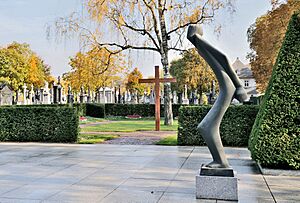Lucien Wercollier facts for kids
Quick facts for kids
Lucien Wercollier
|
|
|---|---|

Lucien Wercollier in 1995
|
|
| Born |
Lucien Wercollier
26 July 1908 |
| Died | 24 April 2002 (age 93) |
| Education | Académie Royale des Beaux-Arts (1927–1931) École nationale supérieure des beaux-arts in Paris (1931–1933) |
| Known for | sculpting |

Lucien Wercollier (born July 26, 1908 – died April 24, 2002) was a famous sculptor from Luxembourg. He created many beautiful artworks.
Lucien Wercollier mostly worked with bronze and marble. But he also used other materials like wood, alabaster, stone, and onyx. His large sculptures found in public places are very important. You can see his art in museums and public spaces in many countries. These include Belgium, France, Germany, Israel, Luxembourg, Switzerland, and the United States.
Contents
Standing Up to Injustice
During World War II, Germany took over Luxembourg. The Nazi government had a group called the Reichskulturkammer. This group made sure all artists created works that fit Nazi ideas. Lucien Wercollier bravely refused to join this group. This made him an enemy of the Nazi occupiers.
The 1942 Strike
In 1942, people in Luxembourg held a big strike against the German occupation. Lucien Wercollier took part in this strike. Because of his actions, he was arrested on September 4, 1942.
He was first held in the Neimënster Abbey in Luxembourg City. Today, this Abbey has a special area called the Lucien Wercollier Cloister. Here, you can see many of his artworks. In 1965, a monument was built in Wiltz to honor the strike. Wiltz was called the "martyred city" because the Germans were very harsh there. Wercollier created two relief sculptures for this monument.
Life in Concentration Camps
After Neimënster Abbey, Wercollier was sent to the Hinzert concentration camp in Germany. This camp was only about 30 kilometers from Luxembourg. Many leaders of the Luxembourg resistance were sent there. Today, one of Wercollier's most famous bronze sculptures stands at Hinzert. It honors the prisoners and those who died there.
Later, Wercollier was moved to Lublin in German-occupied Poland. He was finally freed at the end of the war. He returned to Luxembourg.
His Artistic Journey
After the war, Lucien Wercollier continued to create art. In 1948, he joined a group of artists called the Nouvelle Équipe. They wanted to try new things in art, moving away from old styles. In 1954, he helped start another group called Iconomaques. This group focused on promoting abstract art. Abstract art uses shapes, colors, and forms instead of showing things as they look in real life.
Famous Sculptures Around the World
Lucien Wercollier's sculptures are displayed in many important places:
- His bronze sculpture called Interpénétration is at the Palace of Europe in Strasbourg.
- Another of his sculptures stands in front of the European Court of Justice in Luxembourg City. This artwork was even featured on a Luxembourg postage stamp in 1974.
- His marble sculpture La Vague (which means "The Wave") is at the Neuro-Psychiatric Hospital in Ettelbruck, Luxembourg.
Honoring Important Figures
When countries gave art gifts to the Kennedy Center in Washington, D.C., Luxembourg donated Wercollier's sculpture Ascension. This gift honored John F. Kennedy, a former U.S. President.
Another well-known work is his sculpture Altius. This name means "Higher." It is a tribute to the sport of pole vaulting. You can see it in the Olympic Sculpture Garden at the Olympic Museum in Lausanne, Switzerland.
Remembering the War
Some of Wercollier's most famous works are about the Nazi occupation of Luxembourg during World War II. For example, his bronze sculpture The Political Prisoner stands at the National Monument to the Resistance and to the Deportation. This monument is in the Notre-Dame Cemetery in Limpertsberg, Luxembourg City. You can also see this sculpture at the National Resistance Museum in Esch-sur-Alzette.
Lucien Wercollier also designed the sculpture given to people who receive the Vision for Europe Award.
External sources
- Lucien Wercollier on the Website of the National Museum of History and Art (Musée national d'histoire et d'art), Luxembourg
- Picture of the sculpture Altius in Lausanne
- Review of the Wercollier book by J.-E. Muller


